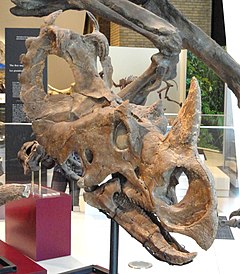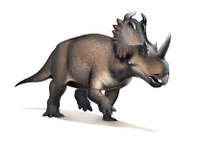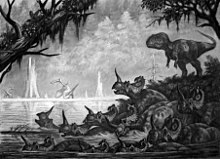| Centrosaurus Temporal range: Late Cretaceous (Campanian), 76.5–75.5 Ma PreꞒ Ꞓ O S D C P T J K Pg N ↓ | |
|---|---|

| |
| Skull ROM 767 from Dinosaur Provincial Park | |
| Scientific classification | |
| Domain: | Eukaryota |
| Kingdom: | Animalia |
| Phylum: | Chordata |
| Clade: | Dinosauria |
| Clade: | †Ornithischia |
| Clade: | †Neornithischia |
| Clade: | †Ceratopsia |
| Family: | †Ceratopsidae |
| Subfamily: | †Centrosaurinae |
| Clade: | †Eucentrosaura |
| Tribe: | †Centrosaurini |
| Genus: | †Centrosaurus Lambe 1904 |
| Species: | †C. apertus |
| Binomial name | |
| †Centrosaurus apertus Lambe 1904 | |
| Synonyms | |
| |
Centrosaurus (/ˌsɛntroʊˈsɔːrəs/ SEN-troh-SOR-əs; lit. 'pointed lizard') is a genus of centrosaurine ceratopsian dinosaur from Campanian age of Late Cretaceous Canada. Their remains have been found in the Dinosaur Park Formation, dating from 76.5 to 75.5 million years ago.
Discovery and naming
See also: Hilda mega-bonebed
The first Centrosaurus remains were discovered and named by paleontologist Lawrence Lambe in strata along the Red Deer River in Alberta. The name Centrosaurus means "pointed lizard" (from Greek kentron, κέντρον, "point" and sauros, σαῦρος, "lizard") and refers to, the series of small hornlets placed along the margin of their frills, not the nasal horns (which were unknown when the dinosaur was named). The genus is not to be confused with the stegosaur Kentrosaurus, the name of which is derived from the same Greek word.
Later, vast bonebeds of Centrosaurus were found in Dinosaur Provincial Park, also in Alberta. Some of these beds extend for hundreds of meters and contain thousands of individuals of all ages and all levels of completion. Scientists have speculated that the high density and number of individuals would be explained if they had perished while trying to cross a flooded river. A discovery of thousands of Centrosaurus fossils near the town of Hilda, Alberta, is believed to be the largest bed of dinosaur bones ever discovered. The area is now known as the Hilda mega-bonebed.
Because of the variation between species and even individual specimens of centrosaurines, there has been much debate over which genera and species are valid, particularly whether Centrosaurus and/or Monoclonius are valid genera, undiagnosable, or possibly members of the opposite sex. In 1996, Peter Dodson found enough variation between Centrosaurus, Styracosaurus, and Monoclonius to warrant separate genera and that Styracosaurus resembled Centrosaurus more closely than either resembled Monoclonius.

Dodson believed one species of Monoclonius, M. nasicornus, may actually have been a female Styracosaurus. His assessments have been partially followed, with other researchers not accepting Monoclonius nasicornus as a female Styracosaurus or Monoclonius as a valid genus. While sexual dimorphism has been proposed for a more basal ceratopsian, Protoceratops, there is no firm evidence for sexual dimorphism in any ceratopsid. Others have synonymized C. nasicornus with C. apertus, or considered it a separate Centrosaurus species: Centrosaurus nasicornus. It has also been suggested as the direct ancestor of Styracosaurus albertensis. A 2014 study of changes during growth in Centrosaurus concluded that C. nasicornus is a junior synonym of C. apertus, representing a middle growth stage.
The species C. brinkmani, described in 2005, was moved to the new genus Coronosaurus in 2012.
Description

Centrosaurus were large dinosaurs, although not as large as some of their relatives, reaching 5–5.5 metres (16–18 ft) long and 2–2.5 metric tons (2.2–2.8 short tons) in body mass situated atop stocky limbs. Like other centrosaurines, Centrosaurus bore a single large horn over their noses. These horns curved forwards or backwards depending on the specimen. Skull ornamentation was reduced as animals aged. The frill was relatively short compared to the total skull length and could grow to over half a meter (68.8 cm) long in the oldest and largest adults.
Centrosaurus is distinguished by having two large hornlets which hook forwards over the frill. A pair of small upwards directed horns is also found over the eyes. The frills of Centrosaurus were moderately long, with fairly large fenestrae and small hornlets along the outer edges.
Classification


The genus Centrosaurus gives its name to the Centrosaurinae subfamily. Its closest relatives appear to be Styracosaurus and Monoclonius. It so closely resembles the latter of these that some paleontologists have considered them to represent the same animal. Other members of the Centrosaurinae subfamily include Pachyrhinosaurus, Avaceratops, Einiosaurus, Albertaceratops, and Achelousaurus.
The cladogram presented below represents a phylogenetic analysis by Chiba et al. (2017):
| Centrosaurinae |
| |||||||||||||||||||||||||||||||||||||||||||||||||||||||||||||||||||||||||||||||||||||||||||||||||||||||||||||||
Paleobiology

Like other ceratopsids, the jaws of Centrosaurus were adapted to shear through tough plant material. The discovery of gigantic bone beds of Centrosaurus in Canada suggest that they were gregarious animals and could have traveled in large herds. A bone bed composed of Centrosaurus and Styracosaurus remains is known from the Dinosaur Park Formation in what is now Alberta. The mass deaths may have been caused by otherwise non-herding animals gathering around a waterhole during a drought. Centrosaurus is found lower in the formation than Styracosaurus, indicating that Centrosaurus was displaced by Styracosaurus as the environment changed over time.

The large frills and nasal horns of the ceratopsians are among the most distinctive facial adornments of all dinosaurs. Their function has been the subject of debate since the first horned dinosaurs were discovered. Common theories concerning the function of ceratopsian frills and horns include defense from predators, combat within the species, and visual display. A 2009 study of Triceratops and Centrosaurus skull lesions found that bone injuries on the skulls were more likely caused by intraspecific combat (horn-to-horn combat) rather than predatory attacks. The frills of Centrosaurus were too thin to be used for defense against predators, although the thicker, solid frills of Triceratops might have evolved to protect their necks. The frills of Centrosaurus were most likely used "for species recognition and/or other forms of visual display".
Paleopathology
A specimen of Centrosaurus apertus recovered from Dinosaur Provincial Park in 1989 was discovered to have crippling osteosarcoma in its right fibula. Examination of the cancerous lesions in the bone suggest the cancer had reached an aggressive stage. The cancer would have resulted in a severe limp that would have made the ceratopsian more vulnerable to predation. However, the fact that it was part of a herd allowed the Centrosaurus to survive much longer than would be expected for an animal infected with such severe disease. The individual itself is believed to have died from drowning in the flash flood that created the Centrosaurus bone bed where it was found. The specimen remains one of the few dinosaur specimens found with severe cancer.
Paleobiogeography

Thomas M. Lehman has observed that Centrosaurus fossils haven't been found outside of southern Alberta even though they are among the most abundant Judithian dinosaurs in the region. Large herbivores like the ceratopsians living in North America during the Late Cretaceous had "remarkably small geographic ranges" despite their large body size and high mobility. This restricted distribution strongly contrasts with modern mammalian faunas whose large herbivores' ranges "typical ... span much of a continent." Fossil material of C. apertus was subsequently described from the strata of the Dinosaur Park Formation in Saskatchewan.
See also
References
- Lambe, L. M. (1904). "On the squamoso-parietal crest of the horned dinosaurs Centrosaurus apertus and Monoclonius canadensis from the Cretaceous of Alberta". Proceedings and Transactions of the Royal Society of Canada. 2. 10 (4): 1–9.
- Arbour, V.M., V. M.; Burns, M. E.; Sissons, R. L. (2009). "A redescription of the ankylosaurid dinosaur Dyoplosaurus acutosquameus Parks, 1924 (Ornithischia: Ankylosauria) and a revision of the genus". Journal of Vertebrate Paleontology. 29 (4): 1117–1135. Bibcode:2009JVPal..29.1117A. doi:10.1671/039.029.0405. S2CID 85665879.
- ^ "Centrosaurus." In: Dodson, Peter & Britt, Brooks & Carpenter, Kenneth & Forster, Catherine A. & Gillette, David D. & Norell, Mark A. & Olshevsky, George & Parrish, J. Michael & Weishampel, David B. The Age of Dinosaurs. Publications International, LTD. p. 135. ISBN 0-7853-0443-6.
- Scientists find dino deathbed, signs of carnage. Edmonton Sun. http://www.edmontonsun.com/news/canada/2010/06/18/14439211.html Archived 2010-06-22 at the Wayback Machine retrieved 18 06 2010
- Dodson, P. (1996). The Horned Dinosaurs: A Natural History. Princeton University Press: Princeton, New Jersey, pp. 197–199. ISBN 0-691-02882-6.
- ^ Ryan, Michael J.; Evans, David C. (2005). "Ornithischian Dinosaurs". In Currie, Phillip J.; Koppelhus, Eva (eds.). Dinosaur Provincial Park: A Spectacular Ancient Ecosystem Revealed. Bloomington: Indiana University Press. pp. 312–348. ISBN 0-253-34595-2.
- Dodson, P. "Quantitative aspects of relative growth and sexual dimorphism in Protoceratops". Journal of Paleontology. 50: 929–940.
- Forster, C. A. (1990). The cranial morphology and systematics of Triceratops, with a preliminary analysis of ceratopsian phylogeny. Ph.D. Dissertation. University of Pennsylvania, Philadelphia. 227 pp.
- Lehman, T. M. (1998). "A gigantic skull and skeleton of the horned dinosaur Pentaceratops sternbergi from New Mexico". Journal of Paleontology. 72 (5): 894–906. Bibcode:1998JPal...72..894L. doi:10.1017/S0022336000027220. S2CID 132807103.
- Sampson, S. D.; Ryan, M.J.; Tanke, D.H. (1997). "Craniofacial ontogeny in centrosaurine dinosaurs (Ornithischia: Ceratopsidae): taphonomic and behavioral phylogenetic implications". Zoological Journal of the Linnean Society. 121 (3): 293–337. doi:10.1111/j.1096-3642.1997.tb00340.x.
- M.J. Ryan and D.C. Evans, 2005, "Ornithischian dinosaurs". In: P.J. Currie and E.B. Koppelhus (eds.), Dinosaur Provincial Park: A Spectacular Ancient Ecosystem Revealed. Indiana University Press, Bloomington pp 312-348
- Russell, L.S. (1930). "Upper Cretaceous dinosaur faunas of North America". Proceedings of the American Philosophical Society. 69 (4): 133–159.
- Paul, G.S., 2010, The Princeton Field Guide to Dinosaurs, Princeton University Press p. 261
- ^ Frederickson, J. A.; Tumarkin-Deratzian, A. R. (2014). "Craniofacial ontogeny in Centrosaurus apertus". PeerJ. 2: e252. doi:10.7717/peerj.252. PMC 3933270. PMID 24688836.
- Ryan, M. J.; Evans, D. C.; Shepherd, K. M.; Sues, H. (2012). "A new ceratopsid from the Foremost Formation (middle Campanian) of Alberta". Canadian Journal of Earth Sciences. 49 (10): 1251. Bibcode:2012CaJES..49.1251R. doi:10.1139/e2012-056.
- Paul, Gregory S. (2010). Princeton Field Guide to Dinosaurs. Princeton University Press. ISBN 978-0-691-13720-9.
- Benson, Roger B. J.; Campione, Nicolás E.; Carrano, Matthew T.; Mannion, Philip D.; Sullivan, Corwin; Upchurch, Paul; Evans, David C. (2014-05-06). "Rates of Dinosaur Body Mass Evolution Indicate 170 Million Years of Sustained Ecological Innovation on the Avian Stem Lineage". PLOS Biology. 12 (5): e1001853. doi:10.1371/journal.pbio.1001853. ISSN 1545-7885. PMC 4011683. PMID 24802911.
- ^ Dodson, P. (1990). "On the status of the ceratopsids Monoclonius and Centrosaurus". In Carpenter, K.; Currie, P.J. (eds.). Dinosaur Systematics: Perspectives and Approaches. Cambridge: Cambridge University Press. pp. 231–243. ISBN 0-521-36672-0.
- ^ Ryan, M.J.; A.P. Russell (2005). "A new centrosaurine ceratopsid from the Oldman Formation of Alberta and its implications for centrosaurine taxonomy and systematics". Canadian Journal of Earth Sciences. 42 (7): 1369–1387. Bibcode:2005CaJES..42.1369R. doi:10.1139/e05-029. hdl:1880/47001. S2CID 128478038.
- ^ Ryan, M.J. (2007). "A new basal centrosaurine ceratopsid from the Oldman Formation, southeastern Alberta". Journal of Paleontology. 81 (2): 376–396. doi:10.1666/0022-3360(2007)81[376:ANBCCF]2.0.CO;2. S2CID 130607301.
- Kentaro Chiba; Michael J. Ryan; Federico Fanti; Mark A. Loewen; David C. Evans (2018). "New material and systematic re-evaluation of Medusaceratops lokii (Dinosauria, Ceratopsidae) from the Judith River Formation (Campanian, Montana)". Journal of Paleontology. 92 (2): 272–288. Bibcode:2018JPal...92..272C. doi:10.1017/jpa.2017.62. S2CID 134031275.
- Eberth, David A.; Getty, Michael A. (2005). "Ceratopsian bonebeds: occurrence, origins, and significance". In Currie, Phillip J.; Koppelhus, Eva (eds.). Dinosaur Provincial Park: A Spectacular Ancient Ecosystem Revealed. Bloomington: Indiana University Press. pp. 501–536. ISBN 0-253-34595-2.
- Rogers, R. R. (1990). "Taphonomy of three dinosaur bone beds in the Upper Cretaceous Two Medicine Formation, northwestern Montana: Evidence for drought-related mortality". PALAIOS. 5 (5). SEPM Society for Sedimentary Geology: 394–41. Bibcode:1990Palai...5..394R. doi:10.2307/3514834. JSTOR 3514834.
- Farke, A.A.; Wolff, E.D.S.; Tanke, D.H. (2009). "Evidence of Combat in Triceratops". PLOS ONE. 4 (1): e4252. Bibcode:2009PLoSO...4.4252F. doi:10.1371/journal.pone.0004252. PMC 2617760. PMID 19172995.
- Ekhtiari, S.; Chiba, K.; Popovic, S.; Crowther, R.; Wohl, G.; Wong, A. K. O.; Tanke, D. H.; Dufault, D. M.; Geen, O. D.; Parasu, N.; Crowther, M. A.; Evans, D. C. (2020). "First case of osteosarcoma in a dinosaur: a multimodal diagnosis". The Lancet Oncology. 21 (8): 1021−1022. doi:10.1016/S1470-2045(20)30171-6. PMID 32758461. S2CID 225473251.
- ^ Lehman, T. M., 2001, Late Cretaceous dinosaur provinciality: In: Mesozoic Vertebrate Life, edited by Tanke, D. H., and Carpenter, K., Indiana University Press, pp. 310-328.
- Demers-Potvin, A. V.; Larsson, H. C. E. (2024). "Occurrence of Centrosaurus apertus (Ceratopsidae: Centrosaurinae) in Saskatchewan, Canada, and expanded dinosaur diversity in the easternmost exposure of the Late Cretaceous (Campanian) Dinosaur Park Formation". Canadian Journal of Earth Sciences. 61 (11): 1127–1155. doi:10.1139/cjes-2023-0125.
External links
- Centrosaurus at The Dinosaur Picture Database
- Centrosaurus, from the Dinosaur Encyclopaedia at Univ. of Illinois at Urbana-Champaign
| Taxon identifiers | |
|---|---|
| Centrosaurus | |



